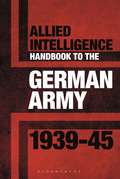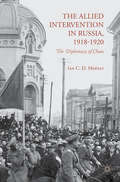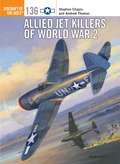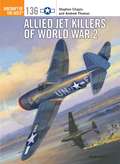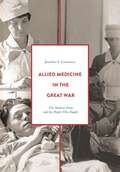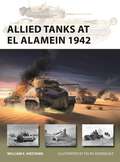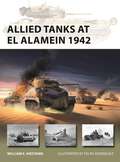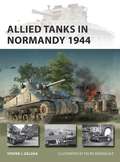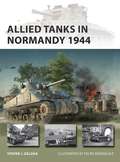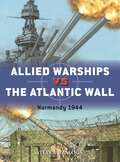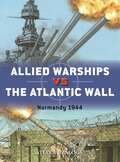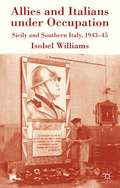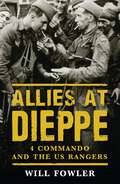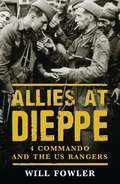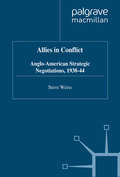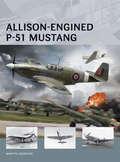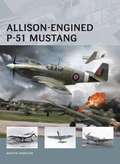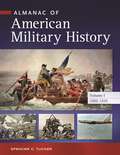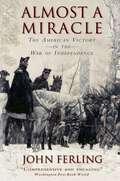- Table View
- List View
Allied Intelligence Handbook to the German Army 1939–45
by Stephen BullWhat did the British or American soldier know about the German Army? Was this knowledge accurate - and just how did he know it? There have been several 'handbooks' of Second World War armies, but they never tell us exactly what the Allied soldier knew at the time, or how he was informed. This is of importance because it influenced both conduct on the battlefield, and the way in which the soldier thought about his enemy. The book explains the background history of the organisations involved, followed by short chapters based around a series of original documents. This puts the original into context and also discusses whether the document that follows was correct in the picture it painted, and what can be deduced about sources and the concerns of the intelligence officers who compiled the material. Most of the documents were produced at the time, by the British War Office or US War Department, and cover different aspects of the German Army, including tactics, weapons, and uniforms. Subjects include: Allied intelligence on the German Army from 1930 onwards, British SIS / MI6 and US Military Intelligence. The organisations responsible, how they worked, and how they changed very rapidly with the coming of war. The role of technology, modern – like the radio transmitter, ancient – as in scouring libraries and periodicals, reports on military manoeuvres and parades. Limitations of 'Ultra' The German army itself, from the tiny force left after Versailles, to the rapid expansion in the late 1930s. Innovation in tanks, tactics, machine guns, rocket weaponry. The problems of gathering intelligence, not just danger, but finance, asking the right questions and the limitations of reporting and distribution.
The Allied Intervention in Russia, 1918-1920: The Diplomacy of Chaos
by I. MoffatThis work explores the reasons for the Allied intervention into Russia at the end of the Great War and examines the military, diplomatic and political chaos that resulted in the failure of the Allies and White Russians to defeat the Bolshevik Revolution.
Allied Jet Killers of World War 2 (Aircraft Of The Aces Ser.)
by Jim Laurier Andrew Thomas Stephen ChapisAllied fighter pilots began encountering German jets – principally the outstanding Me 262 fighter – from the autumn of 1944. Stunned by the aircraft's speed and rate of climb, it took USAAF and RAF units time to work out how to combat this deadly threat as the Luftwaffe targeted the medium and heavy bombers attacking targets across the Reich.A number of high-scoring aces from the Eighth Air Force (Drew, Glover, Meyer, Norley and Yeager, to name but a few) succeeded in claiming Me 262s, Me 163 and Ar 234s during the final months of the campaign, as did RAF aces like Tony Gaze and 'Foob' Fairbanks. The exploits of both famous and little-known pilots will be chronicled in this volume, detailing how they pushed their P-47s, P-51s, Spitfires and Tempests to the limits of their performance in order to down the Luftwaffe's 'wonder weapons'.
Allied Jet Killers of World War 2 (Aircraft of the Aces)
by Jim Laurier Andrew Thomas Mark Postlethwaite Stephen ChapisAllied fighter pilots began encountering German jets – principally the outstanding Me 262 fighter – from the autumn of 1944. Stunned by the aircraft's speed and rate of climb, it took USAAF and RAF units time to work out how to combat this deadly threat as the Luftwaffe targeted the medium and heavy bombers attacking targets across the Reich.A number of high-scoring aces from the Eighth Air Force (Drew, Glover, Meyer, Norley and Yeager, to name but a few) succeeded in claiming Me 262s, Me 163 and Ar 234s during the final months of the campaign, as did RAF aces like Tony Gaze and 'Foob' Fairbanks. The exploits of both famous and little-known pilots will be chronicled in this volume, detailing how they pushed their P-47s, P-51s, Spitfires and Tempests to the limits of their performance in order to down the Luftwaffe's 'wonder weapons'.
Allied Medicine in the Great War: The Medical Front and the People Who Fought
by Jennifer S. LawrenceThis book provides an overview of the history of allied medicine in the Great War. Based on both primary research and secondary literature, it offers a clear and concise account of medical treatment during the Great War, exploring the advancements of the period and the human experience of the medical war.As well as covering European medical work, the book draws on a range of American primary sources and texts in order to address the American medical experience of the First World War, an area that has been neglected by the existing literature.This is an accessible exploration of the medical war, the people involved, and its impact. It is an essential text for undergraduate and postgraduate students of History taking courses on medicine in war, the history of medicine or the Great War.
Allied Medicine in the Great War: The Medical Front and the People Who Fought
by Jennifer S. LawrenceThis book provides an overview of the history of allied medicine in the Great War. Based on both primary research and secondary literature, it offers a clear and concise account of medical treatment during the Great War, exploring the advancements of the period and the human experience of the medical war.As well as covering European medical work, the book draws on a range of American primary sources and texts in order to address the American medical experience of the First World War, an area that has been neglected by the existing literature.This is an accessible exploration of the medical war, the people involved, and its impact. It is an essential text for undergraduate and postgraduate students of history taking courses on medicine in war, the history of medicine or the Great War.
The Allied Occupation of Germany: The Refugee Crisis, Denazification and the Path to Reconstruction (International Library Of Twentieth Century History Ser.)
by Francis Graham-DixonIn the years following World War II, the Allies occupied a shattered Germany. Many elements of this period of Western occupation have been rather neglected in the schema of World War II history, and the story of the sectors administered by the British and Americans is a fascinating one which encompassed revenge for the war, the 'civilising' of 'barbaric' German values and the resettling of refugees as huge numbers of Germans were expelled from Eastern and Central Europe. Britain occupied North-Western Germany for ten years, overseeing the rehabilitation of 'the biggest single forced population movement in modern history'. This was a humanitarian crisis on an unprecedented scale - with hospitals, houses, transport networks and schools mostly destroyed during the war, and the British and Americans running enormous and often inhumane refugee camps.The Allies set about rebuilding the cities which had been destroyed by British and American bombers, and created a new political and economic system - this was part of the 'denazification' of Germany. This book assesses how the British squared their ethical focus on liberalism wit their status as an occupying power responsible for an ongoing humanitarian crisis, and examines the economic, military and political pressures of the period in depth through key turning points - the bombing of Hamburg in 1943 and its aftermath, the case of Schleswig-Holstein unable to absorb overwhelming numbers of expellees, the mismanagement of the refugee camp system and the fallout between occupiers and occupied after the Nuremburg trials of 1945/6.'
Allied Tanks at El Alamein 1942 (New Vanguard #321)
by William E. HiestandExamines Eighth Army's 1,000-strong tank force – rebuilt, reorganized, and equipped with brand-new Sherman and Churchill tanks – that secured victory at the Second Battle of El Alamein.When Eighth Army retired into the defensive line at El Alamein on 30 June 1942, it was tired, dispirited and had lost almost all its tanks during a string of defeats at Gazala, Tobruk and Mersa Matruh. After savage defensive fighting at First Alamein, the reinforced Desert Rats defeated Rommel's last offensive in a tank-to-tank clash at Alam Halfa in September. The next month, a completely rebuilt and reorganized Eighth Army, equipped with over 1,000 tanks including the American M4 Sherman, launched the offensive that would finally drive Rommel out of Africa.Montgomery shaped the Eighth Army according to his own military ideas, and on 23 October was able to attack the Axis defenses with the largest force of armoured divisions in its history, with the 1st, 8th and 10th united in a new 'corps de chasse' intended to defeat the Afrika Korps at its own game, and the 7th and two infantry support tank brigades assigned to support the XXX and XIII Corps. With the exception of the A9, 10 and 13 cruisers of 1940-41, as the offensive began, the Eighth Army contained every type of tank employed during the North Africa campaign.Using detailed illustrations of the tanks involved with an analysis of the tactics employed for battle, this is a focused examination of the tank forces that won the Second Battle of El Alamein - the most famous British Army victory of World War II, and one of the turning points of the war.
Allied Tanks at El Alamein 1942 (New Vanguard #321)
by William E. HiestandExamines Eighth Army's 1,000-strong tank force – rebuilt, reorganized, and equipped with brand-new Sherman and Churchill tanks – that secured victory at the Second Battle of El Alamein.When Eighth Army retired into the defensive line at El Alamein on 30 June 1942, it was tired, dispirited and had lost almost all its tanks during a string of defeats at Gazala, Tobruk and Mersa Matruh. After savage defensive fighting at First Alamein, the reinforced Desert Rats defeated Rommel's last offensive in a tank-to-tank clash at Alam Halfa in September. The next month, a completely rebuilt and reorganized Eighth Army, equipped with over 1,000 tanks including the American M4 Sherman, launched the offensive that would finally drive Rommel out of Africa.Montgomery shaped the Eighth Army according to his own military ideas, and on 23 October was able to attack the Axis defenses with the largest force of armoured divisions in its history, with the 1st, 8th and 10th united in a new 'corps de chasse' intended to defeat the Afrika Korps at its own game, and the 7th and two infantry support tank brigades assigned to support the XXX and XIII Corps. With the exception of the A9, 10 and 13 cruisers of 1940-41, as the offensive began, the Eighth Army contained every type of tank employed during the North Africa campaign.Using detailed illustrations of the tanks involved with an analysis of the tactics employed for battle, this is a focused examination of the tank forces that won the Second Battle of El Alamein - the most famous British Army victory of World War II, and one of the turning points of the war.
Allied Tanks in Normandy 1944 (New Vanguard)
by Steven J. ZalogaWhen Allied tanks began to roll off the landing craft on D-Day, it marked the start of one of the great periods of tank warfare in World War II. Often outgunned by the German Panzers, and fighting in the close confines of bocage country, they nevertheless managed to break out of Normandy and begin the liberation of Europe. It was a battle that was dominated by the Americans' legendary Sherman, but also saw a wide and complex range of armour committed to battle across the many armies involved, from British Churchills and special-purpose 'Funnies' to the Canadians' Ram tank.This book explains the qualities, strengths and weakness of the major British and US tank types as well as associated Allied units in Normandy including the Canadians, Poles, and French, and how they really fought. It will discuss the organization and equipment of the units, providing thumbnail sketches of organization and doctrine as well as statistical data on the types and categories of AFVs that saw action, providing a handy and concise guide for military historians, wargamers and military modelers.
Allied Tanks in Normandy 1944 (New Vanguard #294)
by Steven J. ZalogaWhen Allied tanks began to roll off the landing craft on D-Day, it marked the start of one of the great periods of tank warfare in World War II. Often outgunned by the German Panzers, and fighting in the close confines of bocage country, they nevertheless managed to break out of Normandy and begin the liberation of Europe. It was a battle that was dominated by the Americans' legendary Sherman, but also saw a wide and complex range of armour committed to battle across the many armies involved, from British Churchills and special-purpose 'Funnies' to the Canadians' Ram tank.This book explains the qualities, strengths and weakness of the major British and US tank types as well as associated Allied units in Normandy including the Canadians, Poles, and French, and how they really fought. It will discuss the organization and equipment of the units, providing thumbnail sketches of organization and doctrine as well as statistical data on the types and categories of AFVs that saw action, providing a handy and concise guide for military historians, wargamers and military modelers.
Allied Warships vs The Atlantic Wall: Normandy 1944 (Duel Ser. #128)
by Steven J. ZalogaA fascinating exploration of the often-overlooked gunnery duels between the formidable artillery weapons in the Atlantic Wall defences and the mighty US and Royal Navy battleships. Amphibious landings played a prominent role in Allied operations in the Mediterranean and European theatres in World War II. One of the most effective means to deter and defeat them was through the use of coastal artillery (as witnessed in the disastrous raid on Dieppe in 1942). The growing threat of an Allied invasion of France led the Germans to construct the most elaborate fortifications of the 20th century, the Atlantic Wall, which incorporated coastal artillery as the basis of its strongpoints. Given the high level of uncertainty over where the Allies would land in 1944, the Germans were obliged to deploy large numbers of coastal artillery batteries along the coast of France and the Low Countries, with the heaviest concentrations in the Pas-de-Calais. This fascinating and novel work describes the duel that played out during Operation Neptune/Overlord as the Allies responded to the threat posed by the Atlantic Wall and its modern, steel-reinforced casemates. Among the duels covered are those involving the batteries of HKAA.1261 north of Utah Beach, the naval battery at Longues-sur-Mer between Omaha and Gold beaches, the sinking of USS Corry, and the subsequent Royal Navy and US Navy bombardment of Cherbourg. The sites and locations of key events are clearly shown in helpful 2D maps, and the actions in which these weapons were involved are brought to life in stunning artworks and period photographs.
Allied Warships vs the Atlantic Wall: Normandy 1944 (Duel #128)
by Steven J. ZalogaA fascinating exploration of the often-overlooked gunnery duels between the formidable artillery weapons in the Atlantic Wall defences and the mighty US and Royal Navy battleships.Amphibious landings were an essential tool of Allied military strategy in World War II. The Royal Navy and the US Navy provided operational mobility that allowed the Allies to strike unexpectedly across the vast coastlines of the Mediterranean and Atlantic. Nazi Germany did not have sufficient naval power to seriously contest this, and consequently relied heavily on the huge and costly Atlantic Wall fortification programme. By 1944, the French coast featured more than 1,900 coastal guns over 75mm in calibre. At the heart of this fascinating book by renowned military historian Steven J. Zaloga is the clash between Batterie Hamburg (defending Cherbourg) and the Allied naval bombardment group led by the battleship USS Texas on 25 June 1944. Stunning artworks reveal details of the design, construction and ammunition of the weapons involved, and the locations of important sites are shown on maps. The author also explores the evolution of Allied naval doctrine, which was based on repeated experiences during a succession of amphibious operations, and which enabled the Allies to successfully overcome the coastal gun threat. Illustrated with over 50 period photographs, the result is a fascinating exploration of a key battle during the Allied invasion of mainland Europe.
Allies and Italians under Occupation: Sicily and Southern Italy 1943-45
by I. WilliamsUsing original documents, the Allied Occupation of southern Italy, particularly Sicily and Naples, is illustrated by examining crime and unrest by Allied soldiers, deserters, rogue troops and Italian civilians from drunkenness, theft, rape, and murder to riots, demonstrations, black marketeering and prostitution.
The Allies and the German Problem, 1941-1949: From Cooperation to Alternative Settlement
by Andrew SzanajdaThe Allies and the German Problem, 1941-1949 examines Allied policymaking during the Second World War and the military occupation of postwar Germany, demonstrating how the initial unity of the Allies disintegrated during the postwar military occupation in the face of their separate goals for postwar Germany and Europe.
Allies at Dieppe: 4 Commando and the US Rangers (Osprey Digital Generals Ser.)
by Will FowlerIn August 1942, the Allies launched a raid against the German-held port of Dieppe on the French channel coast. It was largely a disaster, with the Canadian forces bearing the brunt of the catastrophe. However, it wasn't all a failure, and history has tended to overlook the role of 4 Commando, who, along with their US Ranger counter-parts, landed and successfully disabled the German guns threatening the rest of the landings. Their actions proved an excellent demonstration of the military adage "train hard, fight easy†? and showed the advantage of proper operational planning and brilliant leadership. This controversial raid also included members of the Free French and it was the first time US land forces engaged the Germans on mainland Europe. Set in the context of the Dieppe raid as a whole, Will Fowler studies the contribution of No. 4 Commando and Operation Cauldron, and evaluates how and why they achieved their objectives in this daring Commando raid of World War II.
Allies at Dieppe: 4 Commando and the US Rangers
by Will FowlerIn August 1942, the Allies launched a raid against the German-held port of Dieppe on the French channel coast. It was largely a disaster, with the Canadian forces bearing the brunt of the catastrophe. However, it wasn't all a failure, and history has tended to overlook the role of 4 Commando, who, along with their US Ranger counter-parts, landed and successfully disabled the German guns threatening the rest of the landings. Their actions proved an excellent demonstration of the military adage "train hard, fight easy†? and showed the advantage of proper operational planning and brilliant leadership. This controversial raid also included members of the Free French and it was the first time US land forces engaged the Germans on mainland Europe. Set in the context of the Dieppe raid as a whole, Will Fowler studies the contribution of No. 4 Commando and Operation Cauldron, and evaluates how and why they achieved their objectives in this daring Commando raid of World War II.
Allies in Conflict: Anglo-American Strategic Negotiations, 1938-44 (Studies in Military and Strategic History)
by S. WeissThe following study is primarily concerned with the unifying and destructive forces that affected the Anglo-American relationship between 1938 and 1944, as those involved searched for a strategic solution to the war in Europe. President Franklin D. Roosevelt and Prime Minister Winston Churchill's methods of leadership are compared and their personal relationship investigated. Anglo-American tensions are disclosed and assessed with regard to clandestine warfare, special operations and rearming the French and operation ANVIL, the invasion of southern France, is examined for its role in the Anglo-American strategic conflict.
Allison-Engined P-51 Mustang (Air Vanguard #1)
by Richard Chasemore Martyn Chorlton Adam Tooby Mr Ian PalmerWhile the introduction of the Merlin engine did improve the Mustang's performance and produce the bubble-canopied fighters with which we associate the name, credit must be given to the Allison-engined variants that preceded it. From its inception in early 1940, the Mustang's development was extraordinarily rapid – such was the need for a fighter at the time, and the confidence in its design. By early January 1942, the Mustang was in service with the RAF, flying low-level armed reconnaissance operations over Northern France. Despite later Merlin variants arriving in-theatre, this remained a hunting ground for the Allison Mustangs through to D-Day and beyond – a remarkable service length. In American hands the Allison-engined Mustangs performed as dive-bombers and fighters, serving with distinction in North Africa and the Far East.
Allison-Engined P-51 Mustang (Air Vanguard)
by Ian Palmer Richard Chasemore Martyn Chorlton Adam ToobyWhile the introduction of the Merlin engine did improve the Mustang's performance and produce the bubble-canopied fighters with which we associate the name, credit must be given to the Allison-engined variants that preceded it. From its inception in early 1940, the Mustang's development was extraordinarily rapid – such was the need for a fighter at the time, and the confidence in its design. By early January 1942, the Mustang was in service with the RAF, flying low-level armed reconnaissance operations over Northern France. Despite later Merlin variants arriving in-theatre, this remained a hunting ground for the Allison Mustangs through to D-Day and beyond – a remarkable service length. In American hands the Allison-engined Mustangs performed as dive-bombers and fighters, serving with distinction in North Africa and the Far East.
Almanac of American Military History [4 volumes]: [4 volumes]
by Spencer C. TuckerThis almanac provides a comprehensive, chronological overview of all American military history, serving as the standard reference work of its type.Almanac of American Military History is yet another reference work from acclaimed historian Dr. Spencer C. Tucker and ABC-CLIO, offering an unprecedented resource for a wide range of students and researchers. A comprehensive, four-volume title, this almanac traces all of American military history from the European voyages of discovery through 2011, chronicling the pivotal moments that have shaped the United States into the country it is today. In addition to documenting key events, this title presents biographies of more than 250 key individuals and provides information on more than 250 historically significant technologies and weapons systems.A detailed glossary is included, as are discussions of ranks and military awards and decorations. Divided into conflict periods, each chapter includes a detailed chronology, reference-entry sidebars, statistical information, primary-source documents, and a bibliography.
Almanac of American Military History [4 volumes]: [4 volumes]
This almanac provides a comprehensive, chronological overview of all American military history, serving as the standard reference work of its type.Almanac of American Military History is yet another reference work from acclaimed historian Dr. Spencer C. Tucker and ABC-CLIO, offering an unprecedented resource for a wide range of students and researchers. A comprehensive, four-volume title, this almanac traces all of American military history from the European voyages of discovery through 2011, chronicling the pivotal moments that have shaped the United States into the country it is today. In addition to documenting key events, this title presents biographies of more than 250 key individuals and provides information on more than 250 historically significant technologies and weapons systems.A detailed glossary is included, as are discussions of ranks and military awards and decorations. Divided into conflict periods, each chapter includes a detailed chronology, reference-entry sidebars, statistical information, primary-source documents, and a bibliography.
Almost A Miracle: The American Victory in the War of Independence
by John FerlingIn this gripping chronicle of America's struggle for independence, award-winning historian John Ferling transports readers to the grim realities of that war, capturing an eight-year conflict filled with heroism, suffering, cowardice, betrayal, and fierce dedication. As Ferling demonstrates, it was a war that America came much closer to losing than is now usually remembered. General George Washington put it best when he said that the American victory was "little short of a standing miracle." Almost a Miracle offers an illuminating portrait of America's triumph, offering vivid descriptions of all the major engagements, from the first shots fired on Lexington Green to the surrender of General Cornwallis at Yorktown, revealing how these battles often hinged on intangibles such as leadership under fire, heroism, good fortune, blunders, tenacity, and surprise. Ferling paints sharp-eyed portraits of the key figures in the war, including General Washington and other American officers and civilian leaders. Some do not always measure up to their iconic reputations, including Washington himself. The book also examines the many faceless men who soldiered, often for years on end, braving untold dangers and enduring abounding miseries. The author explains why they served and sacrificed, and sees them as the forgotten heroes who won American independence.
Almost A Miracle: The American Victory in the War of Independence
by John FerlingIn this gripping chronicle of America's struggle for independence, award-winning historian John Ferling transports readers to the grim realities of that war, capturing an eight-year conflict filled with heroism, suffering, cowardice, betrayal, and fierce dedication. As Ferling demonstrates, it was a war that America came much closer to losing than is now usually remembered. General George Washington put it best when he said that the American victory was "little short of a standing miracle." Almost a Miracle offers an illuminating portrait of America's triumph, offering vivid descriptions of all the major engagements, from the first shots fired on Lexington Green to the surrender of General Cornwallis at Yorktown, revealing how these battles often hinged on intangibles such as leadership under fire, heroism, good fortune, blunders, tenacity, and surprise. Ferling paints sharp-eyed portraits of the key figures in the war, including General Washington and other American officers and civilian leaders. Some do not always measure up to their iconic reputations, including Washington himself. The book also examines the many faceless men who soldiered, often for years on end, braving untold dangers and enduring abounding miseries. The author explains why they served and sacrificed, and sees them as the forgotten heroes who won American independence.
Alone at Dawn: Medal of Honor Recipient John Chapman and the Untold Story of the World's Deadliest Special Operations Force
by Dan Schilling Lori LongfritzThe New York Times bestselling true account of John Chapman, Medal of Honor recipient and Special Ops Combat Controller, and his heroic one-man stand during the Afghan War, as he sacrificed his life to save the lives of twenty-three comrades-in-arms.In the predawn hours of March 4, 2002, just below the 10,469-foot peak of a mountain in eastern Afghanistan, a fierce battle raged. Outnumbered by Al Qaeda fighters, Air Force Combat Controller John Chapman and a handful of Navy SEALs struggled to take the summit in a desperate bid to find a lost teammate.Chapman, leading the charge, was gravely wounded in the initial assault. Believing he was dead, his SEAL leader ordered a retreat. Chapman regained consciousness alone, with the enemy closing in on three sides.John Chapman's subsequent display of incredible valor -- first saving the lives of his SEAL teammates and then, knowing he was mortally wounded, single-handedly engaging two dozen hardened fighters to save the lives of an incoming rescue squad -- posthumously earned him the Medal of Honor. Chapman is the first airman in nearly fifty years to be given the distinction reserved for America's greatest heroes.Alone at Dawn is also a behind-the-scenes look at the Air Force Combat Controllers: the world's deadliest and most versatile special operations force, whose members must not only exceed the qualifications of Navy SEAL and Army Delta Force teams but also act with sharp decisiveness and deft precision -- even in the face of life-threatening danger.Drawing from firsthand accounts, classified documents, dramatic video footage, and extensive interviews with leaders and survivors of the operation, Alone at Dawn is the story of an extraordinary man's brave last stand and the brotherhood that forged him.
